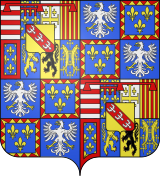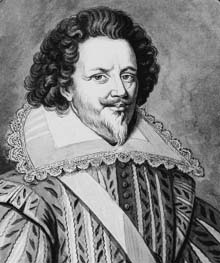Battle of Craon facts for kids
Quick facts for kids Battle of Craon |
|||||||
|---|---|---|---|---|---|---|---|
| Part of the French Wars of Religion | |||||||
 Coat of arms of Philippe Emmanuel, Duke of Mercœur. |
|||||||
|
|||||||
| Belligerents | |||||||
| Catholic League of France
|
|||||||
| Commanders and leaders | |||||||
| Casualties and losses | |||||||
| 1,500 dead Hundreds of prisoners All the artillery taken |
24 dead or wounded | ||||||
The Battle of Craon was a major fight that happened from May 21 to 24, 1592. It was part of the French Wars of Religion, a long period of conflict in France. This battle involved the French Royal army, supported by English soldiers, fighting against a combined force from Spain and the Catholic League of France.
The battle took place near the town of Craon in France. The French Royal army was trying to capture Craon. However, the town's defenders, helped by Catholic forces led by Philippe Emmanuel, Duke of Mercœur, fought back hard. In the end, Spanish troops under Don Juan del Águila arrived and defeated the French and English attackers. This was a big victory for the Catholic and Spanish forces.
Why the Battle Happened
The French Wars of Religion were a series of civil wars in France. They were fought between Catholics and Protestants (called Huguenots). The War of the Three Henrys was a part of these wars. It was about who would be the next king of France.
The Catholic League was a group of French Catholics. They did not want Henry of Navarre, a Protestant, to become king. Philippe Emmanuel, Duke of Mercœur was a powerful leader of the Catholic League in the region of Brittany. He wanted Brittany to be more independent. He also wanted to protect the Catholic Church there.
Mercœur had strong support from Philip II of Spain, the Catholic King of Spain. Philip sent about 7,000 Spanish soldiers to help Mercœur. These soldiers landed in Brittany under the command of Don Juan del Águila.
In early 1592, Henry of Navarre decided to attack the city of Craon. He sent his cousins, the Duke of Montpensier and Prince of Conti, to lead the attack. They gathered their armies in Laval.
On April 14, 1592, Montpensier's army began to surround Craon. He had about 1,200 English soldiers, led by Anthony Wingfield. He also had 800 German soldiers. On May 20, Mercœur and the Marquis de Sablé arrived with their armies to defend Craon.
The Battle of Craon
The fighting for Craon was very intense. The Catholic troops inside the city defended it bravely against the French and English forces.
On May 22, 1592, the Spanish-Catholic army arrived at Craon. They were led by Don Juan del Águila and the Duke of Mercœur. These troops launched a surprise attack on the left side of the Anglo-French army. At the same time, the soldiers inside Craon attacked the right side of the besiegers.
The combined attack was very successful. The Anglo-French forces were defeated. As night fell, Montpensier and his army had to retreat. They went back to Laval and Rennes.
The Spanish forces captured all the cannons, ammunition, flags, and supplies from the defeated army. The English soldiers who were captured faced harsh treatment.
What Happened Next

After the battle, a French commander named Jérôme d'Arradon noticed something important. The Spanish soldiers acted like they were in charge. They seemed to follow only their own King, Philip of Spain, and not Mercœur.
Just a few days later, the town of Laval also fell to the Catholic League. On May 23, 1592, the Prince of Conti retreated further to Chateau-Gontier. The Duke Mercœur and the Marquis of Sablé entered Laval. They then took Chateau-Gontier as well. Boisdauphin was put in charge of Laval, and Louis Champagné became the Governor of Chateau-Gontier.
See also
- Catholic League
- Brittany
- Duchy of Brittany
- Edict of Nantes
- War of the Three Henrys
- French Wars of Religion


